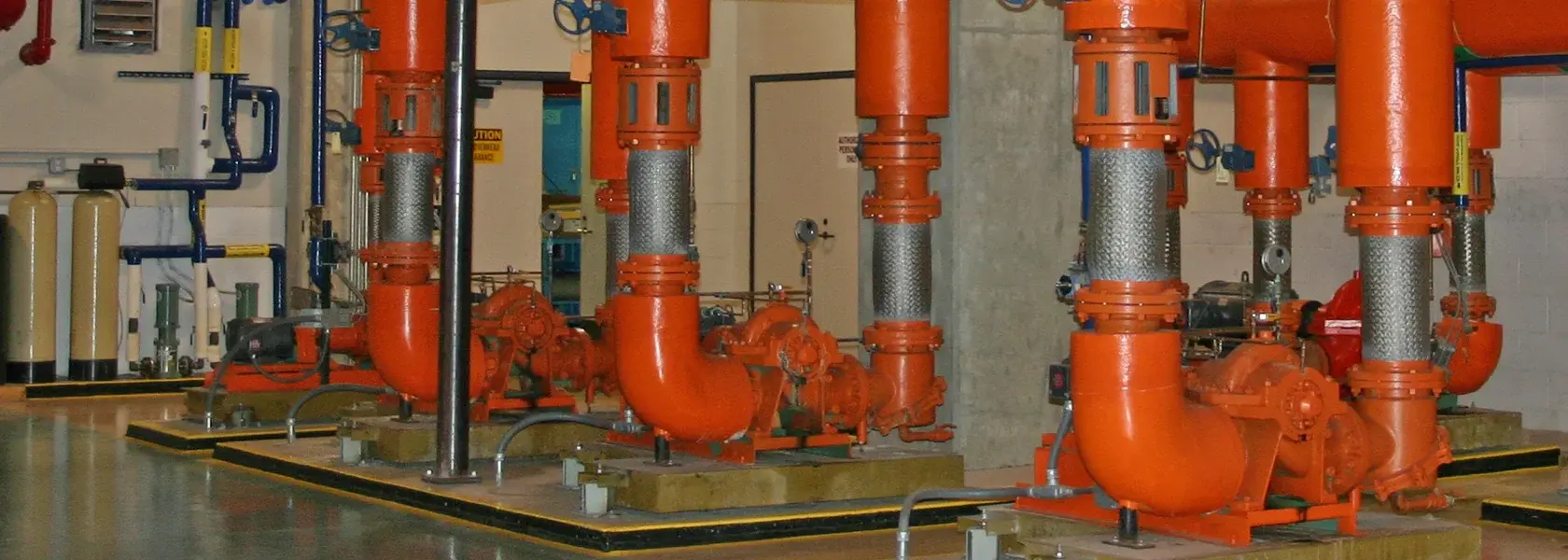
Commissioning (Cx) is a process that checks and documents the design, installation and, testing of a building's systems according to the requirements of the owner. It includes training of the owner's facilities staff in order to understand and operate the building systems efficiently.

A commissioned building provides optimized levels of energy efficiency, indoor air quality, and occupant comfort, as well as reduced operation and maintenance costs.
Commissioning is arguably the single most cost-effective strategy for reducing energy, costs, and greenhouse gas emissions in buildings today.
Historically, the term “commissioning” has referred to the process by which the heating, ventilation, and air conditioning (HVAC) system of a building was tested and balanced according to established standards prior to acceptance by the building owner. The HVAC commissioning did not include building systems that did not directly affect the performance of the HVAC systems. Total building commissioning is a process for achieving, validating, and documenting that the performance of the total building and its systems meets the design needs and requirements. Because all building systems are integrated, a deficiency in one component can result in sub-optimal operation and performance among other components.
Commissioning assures that the design conforms to the owner’s established occupancy requirements, and that all systems are installed and operate as intended. The process should involve the owner’s facilities personnel early in the project, and should seek their input to provide thorough training while generating a feeling of ownership.
The commissioning process ideally begins early in the design phase of the project and continues through the construction and operations phases, culminating in the functional testing of the installed systems and continuing through the contractor’s warranty period.
Commissioning does not function as an additional layer of construction or project management. It is the owner’s way of confirming that the planning, design, construction and operational processes are meeting established goals and delivering a high-quality building. As building systems have grown more complex and reliant on system integration for a number of vital functions due to stringent code requirements and building owner desire for interoperability, building owners have been increasingly turning to commissioning providers in the design, construction, and operations stages of a project.
Want to know all there is to know about building commissioning and what makes PBA a leading building commissioning firm? Download our Building Commissioning Playbook.
Commissioning services can be applied to new construction projects or buildings that have been in service for decades. Commissioning projects will fall into one of the three following categories.
New building commissioning is a thorough quality assurance process that begins during a building’s design phase and continues through construction, occupancy, and operations and warranty phase stages. Commissioning assures that new buildings operate according to the owner’s intent and that the building staff is prepared to operate and maintain its systems and equipment.
Retro-commissioning is the application of the commissioning process to existing buildings; it seeks to determine how a building’s equipment, systems and maintenance procedures can best function together to enhance overall performance. Retro-commissioning can correct issues that occurred during design or construction, or address problems that have developed throughout the building’s life as systems and equipment age and no longer operate at their highest levels. For an example of what retro-commissioning can do, download "Meeting the Energy Challenge", which describes a project we did for Michigan State University.
Re-commissioning is a commissioning process for buildings that have already been commissioned. The decision to re-commission may be triggered by a change in building use or ownership, the onset of operational problems, or some other need. Ideally, a plan for re-commissioning is established as part of a new building’s original commissioning process or an existing building’s retro-commissioning process, with the intent to re-commission a building every few years to assure equipment and processes continue to operate at their optimal level.
Commissioning is a part of overall building management. Duct leakage, heating and cooling waste, and lighting inefficiency are major issues that exist within any building infrastructure. Building commissioning helps resolve issues like these and leads to more sustainable buildings, lower operating expenses, and reduced energy costs and greenhouse gas emissions. Building commissioning is not an interim " fix " for some temporary aberrations in the design / construction processes; rather, commissioning is a necessary ingredient for a successful building.
A typical building project features many contractors and sub-contractors, each of whom are focused solely on their portion of the project and will only conduct testing on the equipment for which they are directly responsible. A commissioning provider will test all equipment in an integrated manner to assess how well different systems and processes are functioning together.
Even the most well-designed and constructed buildings can benefit from commissioning, as providers will run a system through every operating scenario it will undergo during its lifetime and make sure that its actual operation complies with the owner's project requirements and basis of design.
As system controls grow in complexity to meet increased interoperability, energy, and ventilation code requirements, accompanying value engineering and substitutions increasingly result in last-minute design changes that can have adverse and unintended impacts on building performance and energy usage.
The commissioning process is a safeguard against these unintended impacts. Building commissioning examines and fine-tunes building systems to assure that they are designed to operate in a reliable manner. It also looks at how mechanical and electrical systems are integrated with building management systems in order to deliver optimal performance and reduce energy consumption.
Commissioning goes well beyond the standard scope of work for design and construction phases. Identifying and correcting deficiencies during the commissioning process will not only deliver a far more functional building to the owner, it will provide long-term cost savings, reduce construction cost overruns, minimize construction schedule overruns, and reduce the number of issues an owner deals with during occupancy.
Commissioning providers also facilitate training and educating a building’s facility staff on the proper ways to administer the consistent upkeep that will assure a building’s systems continue to operate as designed.
One of the main reasons for retro-commissioning or re-commissioning is system degradation. It is estimated by researchers that as much as 20% of the energy used in an average commercial building is wasted due to poorly operating systems. Buildings systems under-perform for several reasons:
Retro-commissioning or re-commissioning can help rectify these issues.
Commissioning will result in lower operations and maintenance costs over the lifetime of a building. According to the U.S. General Services Administration, 2 industry sources indicate the operating costs of a commissioned building range from 8 percent to 20 percent below that of a non-commissioned building. The one-time investment in commissioning for a building (ranging from 0.5-1.5 percent of construction costs) can result in reduced operating costs over the life of the building. Recent studies indicate that on average the operating and maintenance costs of a commissioned building range from 8 percent to 20 percent below that of a non-commissioned building. Having a building commissioning plan in place is important.
What is retro-comissioning of a building? Retro-commissioning will assure that a building’s systems are functioning at the optimum levels defined in the building’s original commissioning process. If the building had not been previously commissioned, retro-commissioning can identify systems that may not have operated properly since installation and will help adapt the building’s systems to changing usage and occupant needs.
Retro-commissioning can also provide significant operations and cost benefits, especially in buildings that exhibit high energy usage and comfort problems.
Although your building has been commissioned initially, over time a building may have undergone renovations or usage may have changed, and issues common to older buildings start to creep in. System calibrations start to falter, components get out of adjustment, making re-commissioning necessary. Changes in facilities staff necessitate training of new staff so that building operation is optimized.
Every building will benefit from retro-commissioning or re-commissioning. Even though many older buildings had simple heating systems installed, there are opportunities that can be discovered through this process to improve energy efficiency and thermal comfort, as well as identify items that don’t meet code and/or indoor air quality requirements.
If you’ve noticed rising energy costs or consumption, or have systems that run when unnecessary (such as when the building is unoccupied), your building will benefit from retro- or re-commissioning.
As equipment and systems age, they will require more maintenance and upkeep to keep them operating at desired levels. While commissioning can help identify issues and areas of improvement, it can also assure that systems are functioning properly and are integrated together.
Commissioning authorities will also provide necessary training to building staff so that employees will have the knowledge and ability to maintain building systems and operations.
If you hear occupants complaining about the temperature inside a building, or about lighting, or air quality, or others issues, retro-commissioning or re-commissioning will help deliver solutions and programming to get all systems operating as intended.
These processes provide the building owner/facilities manager with a final report (“road map”) summarizing findings, conclusions and recommendations, along with an opinion of probable construction costs associated with the recommendations that help owners to make informed decisions on system upgrades based on cost, energy savings, code compliance, maintenance, or return on investment. Many items identified through these processes have short-term or immediate payback.
A study by the Lawrence Berkeley National Laboratory (LBNL) showed that the costs of retro-commissioning activities range from $0.15 to $0.56 per square foot, while simple payback ranges from 0.8 to 3.5 years. The typical range of energy savings is 3% - 11%. The Building Commissioning Association (BCxA) partnered with the LBNL to produce a two-part 2018 update to the 2009 study, "Building Commissioning: A Golden Opportunity for Reducing Energy Costs and Greenhouse-Gas Emissions.
For new construction projects, the whole building commissioning process can generally be divided into four phases, as described by the Building Commissioning Association’s (BCA) best practices guidelines.
The Pre-Design Phase lays the groundwork for the project, defines the plan for commissioning (Cx), and begins the essential team building process. During this phase the design and commissioning teams are assembled and the Owner’s Project Requirements (OPR) and the building program are developed. All decisions made in ensuing phases should be made with reference to the OPR.
During the design phase, the commissioning process confirms that design documentation (Basis of Design (BOD), plans, specifications, etc.) are consistent with each other, include commissioning requirements and meet the Owner’s Project Requirements (OPR).
Successful construction phase commissioning is a well-coordinated quality assurance and control process that encompasses installation, start-up, functional testing, documentation and training. During the construction phase the commissioning team works to ensure that equipment, systems and assemblies are properly installed, integrated, and operating in a manner that meets the Owner’s Project Requirements (OPR). Functional testing and documentation provide valuable performance benchmarks, acceptance criteria and a baseline for the future operation and ongoing commissioning of the facility.
The Occupancy and Operation Phase normally begins at Substantial Completion when the building is turned over to the Owner, though some construction phase activities may still be in process. In the Occupancy and Operations Phase all uncompleted activities from the construction phase are finished (project closeout activities) as well as the long-term processes for ensuring building performance over time being developed and put into place (ongoing maintenance and performance activities).
Project Closeout Activities
Ongoing Activities
Existing buildings are serviced by the retro-commissioning and re-commissioning processes, which can be divided into the following phases, as defined by the Building Commissioning Association’s best practices.
The objectives of the Planning Phase are to develop/confirm the Owner’s needs and requirements for the facility and document through the development of a Current Facility Requirements (CFR) document and to develop a retro-commissioning or re-commissioning Plan to define the commissioning process for the facility. If a 3rd party consultant will be utilized as the CxP for the project, the Contract with the consultant would be prepared and executed based upon the Owner’s CFR and the required scope of services.
The objective of the Investigation Phase is to conduct the site investigation to compare the actual building conditions and system performance with the Owner’s current operational needs and requirements defined by the CFR. This phase concludes with the completion and review of a Master List of Findings that identifies Facility Improvement Measures (FIMs) that upon implementation will improve building and system performance to meet the CFR, reduce energy and O&M costs and/or improve the indoor environmental quality.
The intent of the Implementation Phase is to implement the Facility Improvement Measures (FIMs) that are selected from the Master List of Findings and to verify that the predicted results and system performance are achieved.
The intent of the Turnover Phase is to assure a smooth hand off and transition from the commissioning process/team to the personnel responsible for operating and maintaining the building over its life-cycle (the O&M personnel). Successful transitions ensure that all necessary documentation, knowledge and systems are provided to the O&M personnel, that the O&M personnel demonstrate the effective use of these tools, and that the implemented improvements become a part of the standard operating practice so that the CFR is met and the positive results persist into the future.
The intent of the Persistence Phase is to assure that all the Facility Improvement Measures continue to perform properly over their life cycle and that systems and tools are provided and employed to facilitate the continuous improvement of facility performance to meet the Current Facility Requirements.

All projects are unique, of course, but in general the commissioning team will consist of the following members:
Building commissioning is becoming more commonplace, and it has plenty of room to grow. Three decades ago, around the time energy efficiency was gaining traction, electric utilities began requiring commissioning on all energy efficiency installations. Since then, commissioning has become a code requirement due to the push towards reducing operating costs through whole building energy efficiency management. Commissioning’s growth and continued success are due to several factors.
Providing occupant safety in public facilities has been a driving force to deliver and commission facilities with enhanced building safety measures. Commissioning of security systems, advanced IT systems that integrate into security systems, fire life safety systems that are also integrated into IT, and HVAC systems will need additional scrutiny when commissioning.
Building projects are increasingly requiring performance certifications such as LEED, Green Globes, ENERGY STAR, and others. The project team must discuss and decide on certification requirements in planning and design phases so that commissioning for certifications procedures and documentation can be included in the OPR and Commissioning Plans.
The benefits of ongoing commissioning are well documented in annual energy savings in studies conducted by many institutions. Risks to operational/business continuity, occupant safety, and health and systems degradation and inefficiency often warrant the added expense of ongoing commissioning.
Commissioning in the Building Code is becoming more prevalent at all levels. It is the CxP's responsibility to understand what is required to meet code for commissioning in the jurisdiction in which the building is being built.
Smart Building technology is entering the mainstream of the building industry on a daily basis. This technology requires integration of most, if not all, of the building systems.
Peter Basso Associates is a leader in commissioning, retro-commissioning and peer review services. To date, we have been involved in more than 450 commissioning projects
 Phil Saoud, PE, CCP, Mechanical Commissioning Lead. Phil Saoud, a 39-year industry veteran, is a Vice President and the Director of the firm’s Contract Administration/Commissioning Department, with a focus on new building and LEED ™ commissioning. He is a Certified Commissioning Professional through the Building Commissioning Association. Phil’s commissioning expertise includes development of project commissioning specifications and manuals, witnessing functional testing, and the development of building owner Operation and Maintenance manuals. He serves as the liaison between the owner’s representatives and the various team members, including contractors, subcontractors, manufacturers’ representatives and any required specialty consultants, and he works to assure clear lines of communication are maintained at all times. Phil has commissioned a variety of building types including multi-story hospital patient towers, K-12 school buildings, automotive proving ground facilities, higher education facilities, labs, office buildings and data centers.
Phil Saoud, PE, CCP, Mechanical Commissioning Lead. Phil Saoud, a 39-year industry veteran, is a Vice President and the Director of the firm’s Contract Administration/Commissioning Department, with a focus on new building and LEED ™ commissioning. He is a Certified Commissioning Professional through the Building Commissioning Association. Phil’s commissioning expertise includes development of project commissioning specifications and manuals, witnessing functional testing, and the development of building owner Operation and Maintenance manuals. He serves as the liaison between the owner’s representatives and the various team members, including contractors, subcontractors, manufacturers’ representatives and any required specialty consultants, and he works to assure clear lines of communication are maintained at all times. Phil has commissioned a variety of building types including multi-story hospital patient towers, K-12 school buildings, automotive proving ground facilities, higher education facilities, labs, office buildings and data centers.
 Phillip S. Allen, PE, LEED AP, QCxP, CCP. Phillip Allen is a vice president with Peter Basso Associates and is a member of the Commissioning and Contract Administration Group. As a Certified Commissioning Professional his duties involve taking a systematic, forensic approach to improving building system performance. He is involved with performing ASHRAE levels I, II, and III Energy Audits on existing buildings and providing recommendations for Energy Conservation Measures. Phil conducts commissioning services for new mechanical and electrical equipment on a variety of building types and systems, several of which concluded as LEED Certified buildings. His engineering experience includes the design of highly complex, technical facilities including engine and vehicular test cell systems, plus a variety of systems associated with manufacturing facilities. Phil has over 30 years of engineering experience coupled with performing contract administration duties such as construction coordination, troubleshooting, and providing engineered solutions.
Phillip S. Allen, PE, LEED AP, QCxP, CCP. Phillip Allen is a vice president with Peter Basso Associates and is a member of the Commissioning and Contract Administration Group. As a Certified Commissioning Professional his duties involve taking a systematic, forensic approach to improving building system performance. He is involved with performing ASHRAE levels I, II, and III Energy Audits on existing buildings and providing recommendations for Energy Conservation Measures. Phil conducts commissioning services for new mechanical and electrical equipment on a variety of building types and systems, several of which concluded as LEED Certified buildings. His engineering experience includes the design of highly complex, technical facilities including engine and vehicular test cell systems, plus a variety of systems associated with manufacturing facilities. Phil has over 30 years of engineering experience coupled with performing contract administration duties such as construction coordination, troubleshooting, and providing engineered solutions.
 Andrew F. Luzenski, PE, CEM, LEED AP. Andrew possesses 20 years’ experience designing HVAC systems and functionally testing HVAC equipment and building systems to evaluate performance, and make recommendations for improvement in both operation and energy consumption for energy audits and retro-commissioning projects. In addition, Andrew serves as our in-house expert for load calculations and energy modeling. He has experience in a variety of energy modeling software packages and has developed proven energy savings calculation spreadsheets. He prepares energy modeling and life cycle cost analyses to guide the design team and owner to optimize building systems, and assists owners in achieve LEED and Energy Star certification.
Andrew F. Luzenski, PE, CEM, LEED AP. Andrew possesses 20 years’ experience designing HVAC systems and functionally testing HVAC equipment and building systems to evaluate performance, and make recommendations for improvement in both operation and energy consumption for energy audits and retro-commissioning projects. In addition, Andrew serves as our in-house expert for load calculations and energy modeling. He has experience in a variety of energy modeling software packages and has developed proven energy savings calculation spreadsheets. He prepares energy modeling and life cycle cost analyses to guide the design team and owner to optimize building systems, and assists owners in achieve LEED and Energy Star certification.
 Nathan Mielke. Nate’s more than 20 years of industry experience encompasses commissioning a wide variety of building types including K-12 schools, college facilities, and government buildings. His commissioning responsibilities include conducting document reviews, preparing commissioning plans, maintaining a commissioning issues log, conducting installation verification site visits, witnessing functional testing, preparing commissioning record documentation, and assisting in resolution of construction and commissioning issues. Nate also has experience in performing infrared testing of equipment and performing underground pipe scoping.
Nathan Mielke. Nate’s more than 20 years of industry experience encompasses commissioning a wide variety of building types including K-12 schools, college facilities, and government buildings. His commissioning responsibilities include conducting document reviews, preparing commissioning plans, maintaining a commissioning issues log, conducting installation verification site visits, witnessing functional testing, preparing commissioning record documentation, and assisting in resolution of construction and commissioning issues. Nate also has experience in performing infrared testing of equipment and performing underground pipe scoping.
Nate holds a HVACR EPA certification: Universal, and ARI Certificate of Competency in Light Commercial A/C and Heating, and is skilled in a variety of engineering software programs.
Spectrum Health Helen DeVos Children’s Hospital LEED® Commissioning | Grand Rapids, Michigan
Peter Basso Associates commissioned the 11-story, 441,000 square foot Helen DeVos Children’s Hospital to meet requirements of LEED v2.2 EA Prerequisite 1 Fundamental Commissioning and EA Credit 3 Enhanced Commissioning, with the goal of achieving LEED® Gold. Learn More...
Commissioning University of Michigan MSRB III
Medical Sciences Research Building III (MSRB III) is a 10-story, 207,000 g.s.f. biomedical research facility on the campus of the University of Michigan. The third in a series of research facilities, MSRB III accommodates approximately 400 people and features laboratories, animal housing, office/conference space and support facilities. Learn More...
Radiology Building Mechanical Systems Retro-Commissioning | East Lansing, Michigan
Michigan State University contracted Peter Basso Associates to perform mechanical systems retro-commissioning for its Radiology Building and provide a summary report. This is MSU’s “flagship” project for retro-commissioning 120 buildings on its main campus. Learn More...
Commissioning First Solar Ohio Manufacturing Plant
First Solar is a 1-million-square-foot manufacturing plant being built for the production of its new Series 6 thin-film solar panels for use by large utility solar farms, on public buildings, and at off-grid industrial sites. This is the second First Solar manufacturing plant and it is located in Lake Township Ohio. Breaking ground in June 2018, the plant is expected to reach full production by late 2019. Learn more…
“PBA’s findings during retro-commissioning of our facility were a great benefit to our organization. They discovered incontestable evidence for needed upgrades and infrastructure replacements. Those discoveries and our decision to implement those repairs have insured our Hospital will thrive into the future.” - Scott Brown, Facilities Manager, Hillsdale Community Health Center